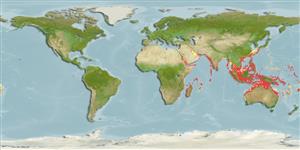Teleostei (teleosts) >
Kurtiformes (Nurseryfishes, cardinalfishes.) >
Apogonidae (Cardinalfishes) > Apogoninae
Etymology: More on author: Lacepède.
Environment: milieu / climate zone / depth range / distribution range
Ecology
Marine; brackish; reef-associated; depth range 1 - 97 m (Ref. 2142), usually 1 - 35 m (Ref. 90102). Tropical
Indo-West Pacific: Red Sea and Persian Gulf, Gulf of Oman and scattered localities in East Africa, Seychelles, India, Sri Lanka, the Indo-Malayan region, and Hong Kong; south to Australia; east to Fiji.
Size / Weight / Age
Maturity: Lm ? range ? - ? cm
Max length : 14.2 cm TL male/unsexed; (Ref. 125969); max. published weight: 28.00 g (Ref. 125969)
Dorsal
spines
(total): 8;
Dorsal
soft rays
(total): 9;
Anal
spines: 2;
Anal
soft rays: 8;
Vertebrae: 24. This species is distinguished by the following characters: D VII+I,9; A II,8-9; greatest body depth 2.5-2.9 SL; head and body with ctenoid scales; preopercle ridge is smooth, edges serrate; no supramaxilla; with basisphenoid; a pair of reduced uroneurals present or absent; epurals 3; free hypurals 5; parhypural are separate; forked caudal fin; head and/or body with one or more light or dark stripes (Ref. 96888). Colour of body mauve on upper back, grading to yellow orange on sides with pair of blue stripes on snout continuing through eye; dark spots along lateral line; caudal fin base with a distinct black bar or large round spot (Ref. 90102).
Common in shallow coastal reefs with moderate currents (Ref. 48636). Also in tidal channels of estuaries (Ref. 48636). Adults usually in small schools comprising pairs (Ref. 48636).
Life cycle and mating behavior
Maturity | Reproduction | Spawning | Eggs | Fecundity | Larvae
Mouthbrooders (Ref. 240). Distinct pairing during courtship and spawning (Ref. 205).
Randall, J.E., T.H. Fraser and E.A. Lachner, 1990. On the validity of the Indo-Pacific cardinalfishes Apogon aureus (Lacepède) and A. fleurieu (Lacepède), with description of a related new species from the Red Sea. Proc. Biol. Soc. Wash. 103(1):39-62. (Ref. 2142)
IUCN Red List Status (Ref. 130435)
Threat to humans
Harmless
Human uses
Fisheries: of no interest
More information
ReferencesAquacultureAquaculture profileStrainsGeneticsElectrophoresesHeritabilityDiseasesProcessingNutrientsMass conversion
Tools
Special reports
Download XML
Internet sources
Estimates based on models
Preferred temperature (Ref.
123201): 24.3 - 29.1, mean 28 °C (based on 2226 cells).
Phylogenetic diversity index (Ref.
82804): PD
50 = 0.5000 [Uniqueness, from 0.5 = low to 2.0 = high].
Bayesian length-weight: a=0.01288 (0.00551 - 0.03009), b=3.10 (2.92 - 3.28), in cm total length, based on LWR estimates for this Genus-body shape (Ref.
93245).
Trophic level (Ref.
69278): 3.6 ±0.4 se; based on size and trophs of closest relatives
Resilience (Ref.
120179): High, minimum population doubling time less than 15 months (Preliminary K or Fecundity.).
Fishing Vulnerability (Ref.
59153): Low vulnerability (10 of 100).
Nutrients (Ref.
124155): Calcium = 103 [51, 177] mg/100g; Iron = 0.779 [0.450, 1.359] mg/100g; Protein = 18.8 [17.7, 20.0] %; Omega3 = 0.155 [0.088, 0.273] g/100g; Selenium = 33.3 [16.3, 65.8] μg/100g; VitaminA = 62.7 [16.5, 227.4] μg/100g; Zinc = 1.63 [1.08, 2.36] mg/100g (wet weight);
